.
He also made what artists call the 'Canon' or Model Statue, as they draw their artistic outlines from it as from a sort of standard; and he alone of mankind is deemed by means of one work of art to have created the art itself. Pliny the Elder, Natural History
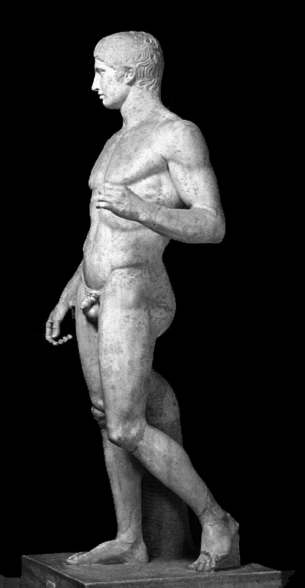
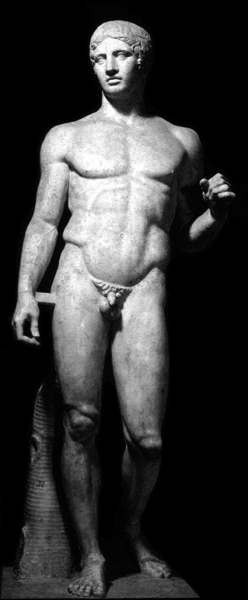
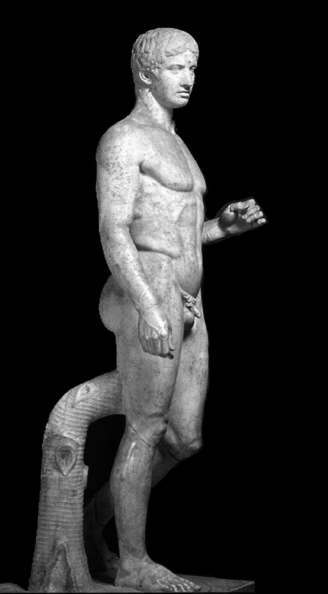
The Doryphoros or Canon, 450-440 BC, Polykleitos (or Polycletus) of Sikyon, 212 cm marble copy from Pompeii (original bronze), now at the Museo Archaeologico, Naples in Italy. Because stone has not the tensile strength of bronze, marble sculptires of bronze copies require supports, usually in the form of tree trunks.
Doryphoros 3D View (German Page)
Polykleitos used specific proportions for example the ratio head/body size is 1/7. The Apoxyomenos of Lysippos uses a ratio 1/8. The Doryphoros is in a so-called chiastic pose with the weight of the body on one foot, the other flexed and at rest. Polykleitos work was produced in Argos.
Beauty, Chrysippos believes, inheres... in the commensurability of the parts, such as that of finger to finger, and all these to the palm and wrist, and of these to the forearm, and of the forearm to the upper arm, and of everything to everything else, just as it is written in the "Canon" of Polykleitos. For having taught us in that treatise all the commensurate proportions of the body, Polykleitos made a work to support his account; he made a statue according to the tenets of his writing, and called it, like the treatise, the "Canon". Galen
The statement made by the sculptor Polykleitos may be suitably repeated for the future. For "perfection," he says, "arises para mikron (meaning "almost"?) through many numbers." Indeed it happens in the same manner in that art [sculpture] that, in finishing off works through many numbers [measurements], they make a slight deviation in each part and in the end these add up to a large error. Philo Mechanicus, Syntaxis
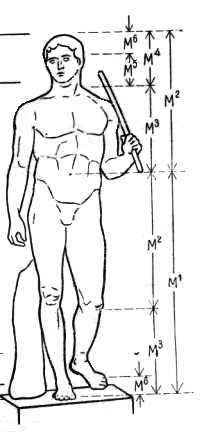
Harmonic Analysis, the golden section and the Doryphoros according to an interpretation by G. D. Grimm. Visit the Web-page Golden Section in Greek's Art for more information from where this image is taken.

Another interpretation that the Doryphoros is described by the Golden Proportion characteristic numbers, according for example to Gyorgy Doczi, The Power of Limits: Proportional Harmonies in Nature, Art and Architecture.
Unfortunately no book of ancient Greek artists survived. Maybe due to the fact that ancient Gods were represented it was considered not worth to produce copies and because realism and beauty were replaced by the interest to represent "spirituality". The Canon, but it was one of the first mathematical descriptions of the “ideal” human body. Later Albrecht Dürer, a mathematician and famous artist provided mathematical rules for the human body proportions including extreme examples of thick and thin figures in his four books about Human proportion. Interesting is the information of the human proportions and measurements given by Vitruvius, a Roman architect, who provided in his books important informations about ancient Greece.
For Nature has so planned the human body that the face from the chin to the top of the forehead and the roots of the hair is a tenth part; also the palm of the hand from the wrist to the top of the middle finger is as much; the head from the chin to the crown, an eighth part; from the top to the breast with the bottom of the neck to the roots of the hair, a sixth part; from the middle of the breast to the crown, a fourth part; a third part of the height of the face is from the bottom of the chin to the bottom of the nostrils; the nose from the bottom of the nostrils to the line between the brows, as much; from that line to the roots of the hair, the forehead is given as the third part. The foot is a sixth of the height of the body; the cubit a quarter, the breast also a quarter. The other limbs also have their own proportionate measurements. And by using these, ancient painters and famous sculptors have attained great and unbounded distinction. Vitruvius, BOOK III, CHAPTER 1 The planning of temples
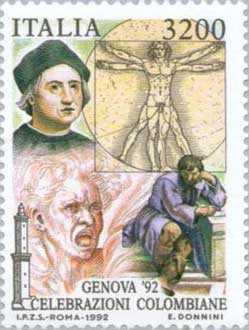
The Vitruvius Man in an Italian Stamp behind the Philosopher Heraclitus from Raphael's School of Athens
The navel is naturally placed in the centre of the human body, and, if in a man lying with his face upward, and his hands and feet extended, from his navel as the centre, a circle be described, it will touch his fingers and toes. It is not alone by a circle, that the human body is thus circumscribed, as may be seen by placing it within a square. For measuring from the feet to the crown of the head, and then across the arms fully extended, we find the latter measure equal to the former; so that lines at right angles to each other, enclosing the figure, will form a square. Vitruvius Architecture and the Vitruvius man of DaVinci
Now in every work of art the basis of its composition is geometry or in other words the means of determining the mutual relationship of its component parts either on plane or in space... And again, since it is mathematics which lends significance to these relationships, it is only a natural step from having perceived them to desiring to portray them. This, in brief, is the genesis of a work of art. M. Bill. The Mathematical Way of Thinking in the Visual Art of Our Time, The Visual Mind: Art and Mathematics, M. Emmer, editor, Leonardo Books-MIT Press, Cambridge, 1993.
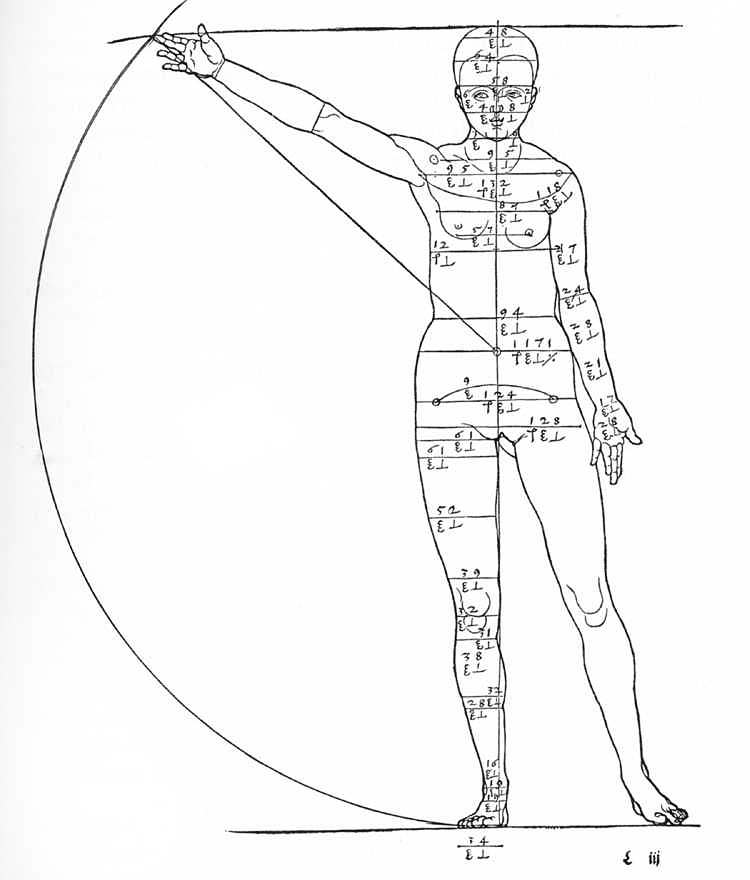
Albrecht Dürer (1471-1528), mathematical human body (as Vitruvius describes with the navel as the center of the body)
| Ancient Greece
Science, Technology , Medicine , Warfare, , Biographies , Life , Cities/Places/Maps , Arts , Literature , Philosophy ,Olympics, Mythology , History , Images Medieval Greece / Byzantine Empire Science, Technology, Arts, , Warfare , Literature, Biographies, Icons, History Modern Greece Cities, Islands, Regions, Fauna/Flora ,Biographies , History , Warfare, Science/Technology, Literature, Music , Arts , Film/Actors , Sport , Fashion --- |

